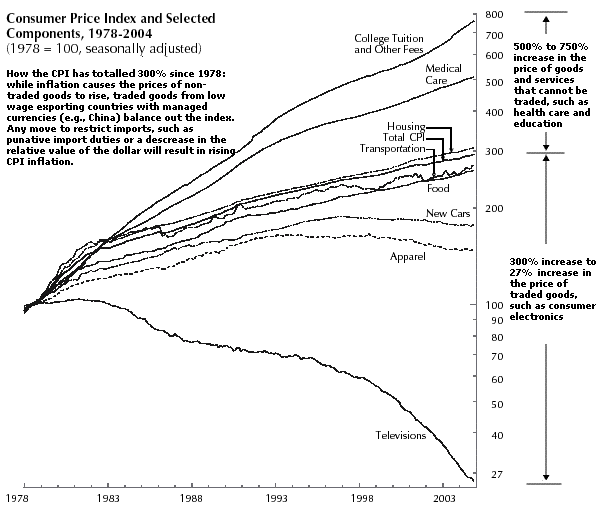 |
Grim Reality
April 2007 (Bill Gross - PIMCO)
This study’s important conclusion for PIMCO and our clients is that if home prices in the U.S. have peaked, and are expected to stay below that peak on a real price basis for the next three years, then the Fed will cut rates and cut them significantly over the next few years in order to revigorate an anemic U.S. economy. Strong global growth (not part of this study’s assumptions) may temper historical parallels and provide a higher floor than would otherwise be the case. Nonetheless, prices for houses that I can see and touch every day outside my office are morphing with bond yields inside my computer screen to produce a reality show that speaks to an ongoing bond bull market of still undefined proportions.
AntiSpin: What if we get the other kind of apocalypse? Not the bond-friendly disinflationary kind that drives interest rates down but the bond wrecking rising inflation and contracting economy–stagflationary–type? That's what former Harvard president Lawrence H. Summers believes.April 2007 (Bill Gross - PIMCO)
This study’s important conclusion for PIMCO and our clients is that if home prices in the U.S. have peaked, and are expected to stay below that peak on a real price basis for the next three years, then the Fed will cut rates and cut them significantly over the next few years in order to revigorate an anemic U.S. economy. Strong global growth (not part of this study’s assumptions) may temper historical parallels and provide a higher floor than would otherwise be the case. Nonetheless, prices for houses that I can see and touch every day outside my office are morphing with bond yields inside my computer screen to produce a reality show that speaks to an ongoing bond bull market of still undefined proportions.
An occasion for redo economics
March 28, 2007 (Lawrence H. Summers - LA Times)
With prospects for a big slowdown, it's perilous to correct yesterday's mistakes.
Now the growth syllogism is in real doubt. Subprime-sector foreclosures will bloat the supply of houses. At the same time, reductions in capital in housing finance and more rigorous credit standards will reduce the demand for new homes. As consumers face upward resets on their mortgage rates and are unable to refinance, and as home-equity, automobile and credit-card lending tighten, consumption will decline.
If that happens, and U.S. interest rates fall or appear likely to fall, there is the real possibility that the foreign lending to the United States will start to dry up, leading to a combination of higher long-term interest rates and a weaker dollar. This would tend to raise inflationary pressures, transmit U.S. weakness to the rest of the world and, by discouraging foreign demand for U.S. assets, could lead to further downward pressure on investment in plants, equipment and commercial real estate.
March 28, 2007 (Lawrence H. Summers - LA Times)
With prospects for a big slowdown, it's perilous to correct yesterday's mistakes.
Now the growth syllogism is in real doubt. Subprime-sector foreclosures will bloat the supply of houses. At the same time, reductions in capital in housing finance and more rigorous credit standards will reduce the demand for new homes. As consumers face upward resets on their mortgage rates and are unable to refinance, and as home-equity, automobile and credit-card lending tighten, consumption will decline.
If that happens, and U.S. interest rates fall or appear likely to fall, there is the real possibility that the foreign lending to the United States will start to dry up, leading to a combination of higher long-term interest rates and a weaker dollar. This would tend to raise inflationary pressures, transmit U.S. weakness to the rest of the world and, by discouraging foreign demand for U.S. assets, could lead to further downward pressure on investment in plants, equipment and commercial real estate.
 |
Stocks Fall on Bernanke Inflation Remark
Stocks Slide Following Fed Chief Testimony on Inflation, Subprime Lenders
Stocks slid further Wednesday after Federal Reserve Chairman Ben Bernanke appeared to chide investors who may have looked past concerns about inflation following Fed comments last week. The Dow Jones industrials fell more than 100 points.
What exactly did Ben say that sent the markets down?Stocks Slide Following Fed Chief Testimony on Inflation, Subprime Lenders
Stocks slid further Wednesday after Federal Reserve Chairman Ben Bernanke appeared to chide investors who may have looked past concerns about inflation following Fed comments last week. The Dow Jones industrials fell more than 100 points.
Testimony of Chairman Ben S. Bernanke
March 28, 2007
The principal source of the slowdown in economic growth that began last spring has been the substantial correction in the housing market.
Although the turmoil in the subprime mortgage market has created severe financial problems for many individuals and families, the implications of these developments for the housing market as a whole are less clear.
Apparently Ben hasn't read the Fed's own September of 2005 report Monetary Policy and House Prices: A Cross-Country Study (pdf). It concludes: "Foreign industrial economies have experienced many large swings in house prices over the past thirty-five years, and the latest rise has been the most dramatic on record. The extent of the rise and its synchronization across countries raises concerns that, if history is any guide, real house prices are quite likely to fall or at least stagnate in a number of industrial countries in the future. Furthermore, the pro-cyclicality of real house prices also suggests that their downward correction will be associated with some slowing of consumption and residential investment, which could contribute to an economic downturn."March 28, 2007
The principal source of the slowdown in economic growth that began last spring has been the substantial correction in the housing market.
Although the turmoil in the subprime mortgage market has created severe financial problems for many individuals and families, the implications of these developments for the housing market as a whole are less clear.
[US] Business spending has also slowed recently. Outside the United States, economic activity in our major trading partners has continued to grow briskly.
Good thing, too, because if US trade partners aren't growing, then they are not producing the economic surplus that the US needs to consume to maintain the system of Trade Deficit Financing for the US economy. Ben's middle ground conclusion:
Overall, the economy appears likely to continue to expand at a moderate pace over coming quarters.
And, finally, an ass-covering close to the topic of the economy before moving on to the topic of inflation:This forecast is subject to a number of risks. To the downside, the correction in the housing market could turn out to be more severe than we currently expect, perhaps exacerbated by problems in the subprime sector. Moreover, we could yet see greater spillover from the weakness in housing to employment and consumer spending than has occurred thus far.
Inflation: "These data are too hot," says Ben Riding Hood:Although core inflation seems likely to moderate gradually over time, the risks to this forecast are to the upside.
He goes on to make the case to his bond market audience that the horror of impending wage inflation are worse than the risk that the economy is slowing too much.However, a less benign possibility is that tight product markets might allow firms to pass some or all of their higher labor costs through to prices. In this case, increases in nominal compensation would not translate into increased purchasing power for workers but would add to inflation pressures. Thus, the high level of resource utilization remains an important upside risk to continued progress in reducing inflation.
The Fed would like nothing better than to cut rates and get the next bubble going, but can't without a clear and present finance danger–a crash. So expect to get similar blah, blah, blah until the inevitable financial accident, revelation of fraud, or clear sign of self-reinforcing weakness in the economy–the menu of pins to pop any asset bubble–shows up.  |
Not smarter than a 5th grader: How runaway inflation has slipped under our radar
March 26, 2007 (Jane Stillwater's Web Log)
We need to stop being sidetracked by statistics and to start learning to trust our own experience at the grocery store and the gas pump instead. We need to start flying by the seat of our pants.
Remember that old adage, "If a tree falls in the forest and no one is around to hear it, does it still make a sound?" Well, here's a new adage. "If a price raises at the supermarket and the media doesn't report it, does inflation still exist?" You bet!
If inflation cost Jimmy Carter the presidency after only one term, how come Bush wasn't thrown out of the White House in 2004? Two reasons. First, the rate of runaway inflation since GWB took over the White House wasn't hyped in the news constantly like it had been during the 1980 presidential election race. And, second, "If election fraud steals an election, does the winner still get to be President?"
PS: Instead of using the Consumer Price Index to measure inflation rates, we now rely on the Core CPI, which doesn't record dramatic changes in housing and energy costs. According to economist Ann Berg, the Core CPI only reflects that we are now buying more stuff at dollar stores. Dollar store purchases are now keeping inflation down? What? The once-mighty American economy is now being kept safe from inflation because low prices in DOLLAR STORES are forcing the CPI down? That's pathetic.
According to Berg, "Core CPI reveals no inflation because it tracks manufactured goods that have cheapened over time, the result of the entrance of a billion third world workers since 1990."
Digging back into the iTulip archives, we find the following faux letter from the Bureau of Labor Statistics on the subject.March 26, 2007 (Jane Stillwater's Web Log)
We need to stop being sidetracked by statistics and to start learning to trust our own experience at the grocery store and the gas pump instead. We need to start flying by the seat of our pants.
Remember that old adage, "If a tree falls in the forest and no one is around to hear it, does it still make a sound?" Well, here's a new adage. "If a price raises at the supermarket and the media doesn't report it, does inflation still exist?" You bet!
If inflation cost Jimmy Carter the presidency after only one term, how come Bush wasn't thrown out of the White House in 2004? Two reasons. First, the rate of runaway inflation since GWB took over the White House wasn't hyped in the news constantly like it had been during the 1980 presidential election race. And, second, "If election fraud steals an election, does the winner still get to be President?"
PS: Instead of using the Consumer Price Index to measure inflation rates, we now rely on the Core CPI, which doesn't record dramatic changes in housing and energy costs. According to economist Ann Berg, the Core CPI only reflects that we are now buying more stuff at dollar stores. Dollar store purchases are now keeping inflation down? What? The once-mighty American economy is now being kept safe from inflation because low prices in DOLLAR STORES are forcing the CPI down? That's pathetic.
According to Berg, "Core CPI reveals no inflation because it tracks manufactured goods that have cheapened over time, the result of the entrance of a billion third world workers since 1990."
To: All Departments
From: Patty Jackman, US Dept. of Labor, Bureau of Labor Statistics
Date: February 3, 2000
Subject: Revision of CPI
Due to rising oil prices, the Bureau of Labor Statistics announces a new formulation of the CPI retroactive to January1, 2000.
All items, U.S. city average, all urban consumers, 1982-84=100, 1-month percent change, seasonally adjusted.
Old CPI Cost Items -> New CPI Cost Items
Food and beverages -> Food and beverages at discount grocery stores
Housing -> Tenement housing
Apparel -> Consignment store clothing
Transportation -> Bicycles, skateboards, shoes
Medical care -> Beer, martinis, television
Recreation -> Same as above
Education and communication -> Network television shows and Buck-a-Book store items
Other goods and services -> Air, sun, snow
Energy -> Burning tires in the back yard
Regards,
Patty Jackman
Division Weasel
US Dept. of Labor
Bureau of Labor Statistics
We meant it as a joke. Little did we know, this appears to be more or less what the BLS did.From: Patty Jackman, US Dept. of Labor, Bureau of Labor Statistics
Date: February 3, 2000
Subject: Revision of CPI
Due to rising oil prices, the Bureau of Labor Statistics announces a new formulation of the CPI retroactive to January1, 2000.
All items, U.S. city average, all urban consumers, 1982-84=100, 1-month percent change, seasonally adjusted.
Old CPI Cost Items -> New CPI Cost Items
Food and beverages -> Food and beverages at discount grocery stores
Housing -> Tenement housing
Apparel -> Consignment store clothing
Transportation -> Bicycles, skateboards, shoes
Medical care -> Beer, martinis, television
Recreation -> Same as above
Education and communication -> Network television shows and Buck-a-Book store items
Other goods and services -> Air, sun, snow
Energy -> Burning tires in the back yard
Regards,
Patty Jackman
Division Weasel
US Dept. of Labor
Bureau of Labor Statistics
The era when voters have been willing to put with the ruse of the rigged CPI numbers and the Fed program to keep their wages in check may be coming to an end. As long as it looked like Joe and Jane taxpayer had a seat at the Bubble Economy table where they too could pick up some scrap capital gains from the sales of inflated assets, first in the stock market bubble and then the housing bubble, the nudge-nudge, wink-wink CPI was tolerable. Now that the housing bubble has come to an end, the inflation reality is becoming politicized, and pressure is rising on the Fed to do more than give lip service to inflation. At the same time, if Summers is right, US dependence on foreign absorption of US inflation may be coming to an end, too.
Remember what happened the last time politics got the Fed serious about inflation: precious metals prices collapsed. The politicization of inflation bears careful scrutiny.
The Fed needs a crash in order to cut rates. But more than that, it desperately needs a new asset bubble to keep the FIRE Economy chugging along. We don't yet know where it is going to form but as of Tuesday, thanks to J–our mystery writer–we may have come upon one potential tool to help us locate it before the fact.
Stay tuned.
Comment